英语科技论文写作结课论文
英语科技作文的总结
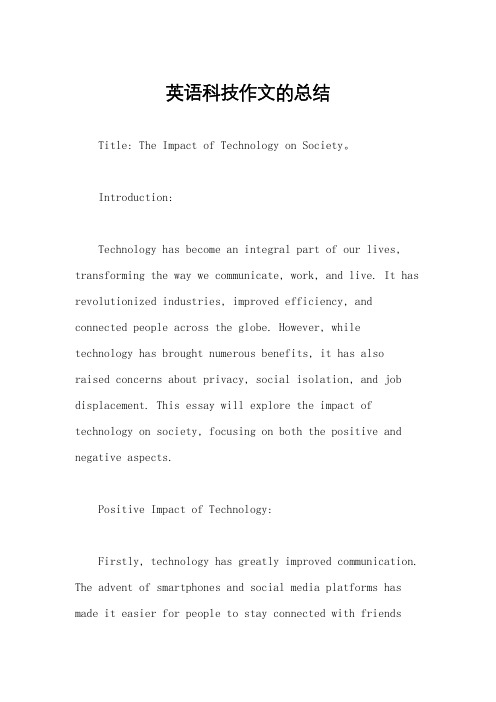
英语科技作文的总结Title: The Impact of Technology on Society。
Introduction:Technology has become an integral part of our lives, transforming the way we communicate, work, and live. It has revolutionized industries, improved efficiency, and connected people across the globe. However, while technology has brought numerous benefits, it has also raised concerns about privacy, social isolation, and job displacement. This essay will explore the impact of technology on society, focusing on both the positive and negative aspects.Positive Impact of Technology:Firstly, technology has greatly improved communication. The advent of smartphones and social media platforms has made it easier for people to stay connected with friendsand family, regardless of their geographical location. Furthermore, video conferencing tools have facilitated remote work and collaboration, enhancing productivity and reducing travel costs.Secondly, technology has transformed various industries, leading to increased efficiency and economic growth. For instance, automation and robotics have revolutionized manufacturing processes, resulting in higher productionrates and improved quality control. Additionally,technology has enabled the development of advanced medical equipment and treatments, saving countless lives and enhancing healthcare outcomes.Moreover, technology has expanded access to education and information. Online learning platforms provide opportunities for individuals to acquire knowledge andskills from the comfort of their homes. Furthermore, the internet has made information readily available, allowing people to stay informed and learn about diverse topics.Negative Impact of Technology:Despite its advantages, technology has also raised concerns about privacy and data security. With the increasing reliance on digital platforms, personal information can be easily accessed and exploited by cybercriminals. Moreover, the collection and analysis of data by tech companies have raised ethical questions regarding the protection of individuals' privacy.Furthermore, technology has contributed to social isolation and decreased interpersonal interactions. The rise of social media has led to a decline in face-to-face communication, with individuals often prioritizing virtual connections over real-life relationships. This trend has resulted in feelings of loneliness and disconnection among many people.Additionally, the automation of jobs has led to concerns about unemployment and job displacement. As technology continues to advance, certain roles may become obsolete, leaving many individuals unemployed. This requires a shift in the workforce, with a focus onacquiring new skills and adapting to the changing job market.Conclusion:In conclusion, technology has had a profound impact on society, bringing numerous benefits while also raising concerns. It has improved communication, transformed industries, and expanded access to education and information. However, it has also raised issues related to privacy, social isolation, and job displacement. To ensure a positive impact, it is crucial for individuals, governments, and tech companies to work together to address these challenges and harness the potential of technologyfor the betterment of society.。
学校科技课程英文作文
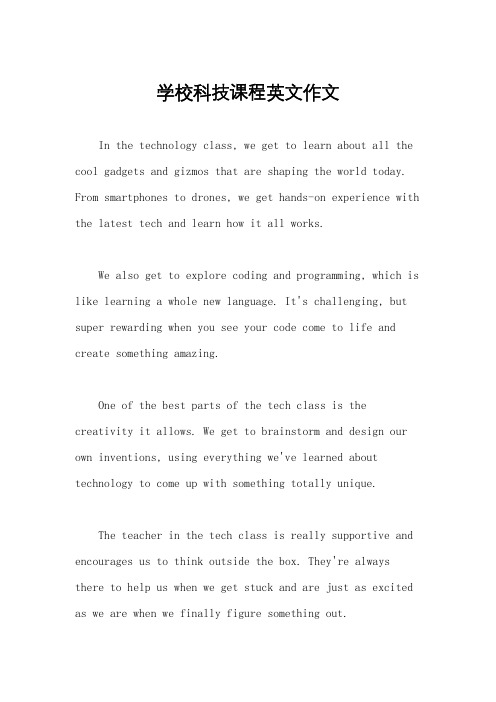
学校科技课程英文作文In the technology class, we get to learn about all the cool gadgets and gizmos that are shaping the world today. From smartphones to drones, we get hands-on experience with the latest tech and learn how it all works.We also get to explore coding and programming, which is like learning a whole new language. It's challenging, but super rewarding when you see your code come to life and create something amazing.One of the best parts of the tech class is thecreativity it allows. We get to brainstorm and design our own inventions, using everything we've learned about technology to come up with something totally unique.The teacher in the tech class is really supportive and encourages us to think outside the box. They're always there to help us when we get stuck and are just as excited as we are when we finally figure something out.Overall, the tech class is a blast. It's a mix of hands-on learning, problem-solving, and creativity that keeps us engaged and excited to come to class every day. It's definitely one of the most interesting and relevant subjects we study in school.。
科技英语论文(合集5篇)
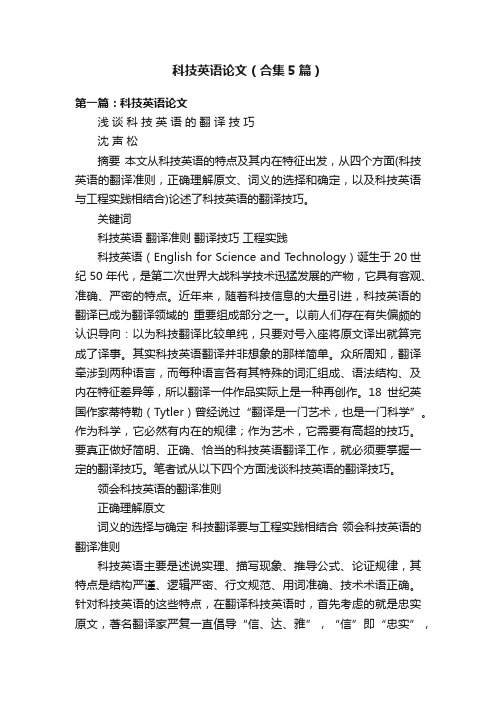
科技英语论文(合集5篇)第一篇:科技英语论文浅谈科技英语的翻译技巧沈声松摘要本文从科技英语的特点及其内在特征出发,从四个方面(科技英语的翻译准则,正确理解原文、词义的选择和确定,以及科技英语与工程实践相结合)论述了科技英语的翻译技巧。
关键词科技英语翻译准则翻译技巧工程实践科技英语(English for Science and Technology)诞生于20世纪50年代,是第二次世界大战科学技术迅猛发展的产物,它具有客观、准确、严密的特点。
近年来,随着科技信息的大量引进,科技英语的翻译已成为翻译领域的重要组成部分之一。
以前人们存在有失偏颇的认识导向:以为科技翻译比较单纯,只要对号入座将原文译出就算完成了译事。
其实科技英语翻译并非想象的那样简单。
众所周知,翻译牵涉到两种语言,而每种语言各有其特殊的词汇组成、语法结构、及内在特征差异等,所以翻译一件作品实际上是一种再创作。
18世纪英国作家蒂特勒(Tytler)曾经说过“翻译是一门艺术,也是一门科学”。
作为科学,它必然有内在的规律;作为艺术,它需要有高超的技巧。
要真正做好简明、正确、恰当的科技英语翻译工作,就必须要掌握一定的翻译技巧。
笔者试从以下四个方面浅谈科技英语的翻译技巧。
领会科技英语的翻译准则正确理解原文词义的选择与确定科技翻译要与工程实践相结合领会科技英语的翻译准则科技英语主要是述说实理、描写现象、推导公式、论证规律,其特点是结构严谨、逻辑严密、行文规范、用词准确、技术术语正确。
针对科技英语的这些特点,在翻译科技英语时,首先考虑的就是忠实原文,著名翻译家严复一直倡导“信、达、雅”,“信”即“忠实”,也就是要完整地、准确地表达原作的思想内容,这是科技英语翻译的首要要求;其次要讲究的就是“达”,即通顺。
著名学者傅雷先生曾指出:“理想的译文仿佛是原作者的中文写作。
”海外学者钱歌川先生也指出“科技英语的翻译虽不像小说那样要求雅致优美,姿态横生,也不像翻译诗歌那样要求抑扬顿挫,押韵合辙,但要求至少文从字顺,明白流畅。
大学生科技英语写作范文
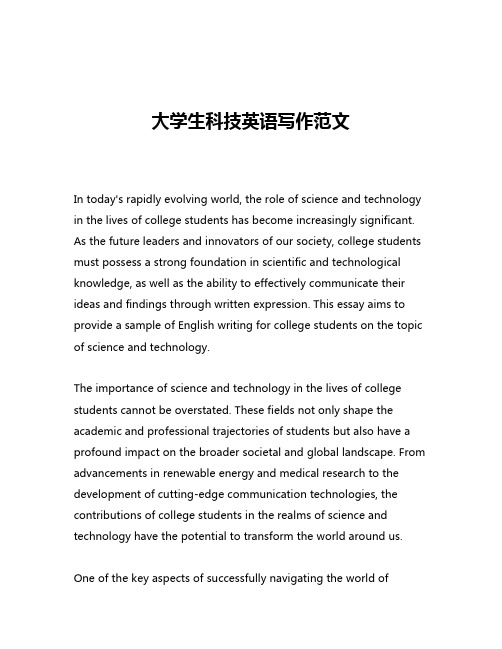
大学生科技英语写作范文In today's rapidly evolving world, the role of science and technology in the lives of college students has become increasingly significant. As the future leaders and innovators of our society, college students must possess a strong foundation in scientific and technological knowledge, as well as the ability to effectively communicate their ideas and findings through written expression. This essay aims to provide a sample of English writing for college students on the topic of science and technology.The importance of science and technology in the lives of college students cannot be overstated. These fields not only shape the academic and professional trajectories of students but also have a profound impact on the broader societal and global landscape. From advancements in renewable energy and medical research to the development of cutting-edge communication technologies, the contributions of college students in the realms of science and technology have the potential to transform the world around us.One of the key aspects of successfully navigating the world ofscience and technology as a college student is the ability to effectively communicate one's ideas and findings through written expression. This skill is particularly crucial in the academic setting, where students are often required to produce research papers, lab reports, and technical documents that showcase their knowledge and insights. Mastering the art of science and technology writing not only enhances a student's academic performance but also prepares them for the demands of the professional world, where clear and concise communication is highly valued.To excel in science and technology writing, college students must possess a strong command of the English language, a deep understanding of the subject matter, and the ability to organize and present their ideas in a logical and coherent manner. This involves the use of appropriate scientific terminology, the incorporation of relevant data and evidence, and the ability to critically analyze and interpret research findings.One of the key challenges faced by college students in science and technology writing is the need to strike a balance between technical accuracy and accessibility. While it is important to demonstrate a thorough understanding of the subject matter, students must also be able to communicate their ideas in a way that is understandable to a broader audience, including those who may not have a background in the field. This requires the ability to translate complex scientificconcepts into clear and concise language, using examples and analogies to illustrate key points.Another important aspect of science and technology writing for college students is the ability to effectively organize and structure their work. This involves the use of well-defined sections, such as an introduction, literature review, methodology, results, and discussion, to ensure that the reader can easily follow the flow of the argument and understand the significance of the findings. Additionally, the use of appropriate formatting, citation styles, and visual aids, such as graphs and tables, can enhance the overall quality and impact of the written work.Beyond the technical aspects of science and technology writing, college students must also develop a strong sense of critical thinking and analytical skills. This involves the ability to critically evaluate existing research, identify gaps in the literature, and formulate innovative hypotheses and research questions. By engaging in this process, students can not only demonstrate their understanding of the subject matter but also contribute to the advancement of scientific and technological knowledge.In conclusion, the ability to effectively communicate ideas and findings in the realm of science and technology is a crucial skill for college students. By mastering the art of English writing in thesefields, students can not only enhance their academic performance but also position themselves for success in the professional world. Through the development of strong technical writing skills, critical thinking abilities, and a deep understanding of the subject matter, college students can play a vital role in shaping the future of science and technology and contributing to the betterment of our society.。
英文论文总结范文

Introduction:In recent years, technology has become an integral part of our lives, transforming various sectors, including education. The integration of technology in the educational field has led to significant changes in teaching methods, learning experiences, and overall academic performance. This paper aims to provide a comprehensive review of the impact of technology on education, discussing its advantages, challenges, andfuture prospects.Advantages of Technology in Education:1. Enhanced Learning Experience:Technology has revolutionized the way students learn. With the use of interactive multimedia tools, such as videos, simulations, and virtual reality, students can engage with the subject matter more effectively. This active learning approach fosters better understanding and retention of information.2. Access to a Wealth of Resources:The internet has made a vast array of educational resources readily available to students and teachers. Online libraries, educational websites, and e-books provide access to a wide range of materials, enabling students to explore various topics beyond the limitations of traditional textbooks.3. Personalized Learning:Technology allows for personalized learning experiences. Adaptive learning platforms can tailor the learning content and pace toindividual student needs, ensuring that each student receives the appropriate level of support and challenge.4. Collaboration and Communication:Technology facilitates collaboration among students and teachers, regardless of geographical barriers. Online discussion forums, videoconferencing, and collaborative tools enable students to work together on projects, enhancing their teamwork and communication skills.Challenges of Technology in Education:1. Digital Divide:The digital divide refers to the gap between individuals with and without access to digital technology. This disparity can hinder educational opportunities for underprivileged students, as they may not have access to the necessary devices and internet connectivity.2. Overreliance on Technology:An excessive reliance on technology can lead to reduced criticalthinking and problem-solving skills. Students may become dependent on digital tools for answers, rather than developing their own analytical abilities.3. Privacy and Security Concerns:The use of technology in education raises concerns about data privacy and security. Schools must ensure that students' personal information is protected from unauthorized access and misuse.Future Prospects:1. Integration of Artificial Intelligence:The integration of artificial intelligence (AI) in education holds great potential. AI-powered tools can provide personalized learning experiences, automate administrative tasks, and assist teachers in identifying struggling students.2. Expansion of Online Education:The global pandemic has accelerated the adoption of online education. As technology continues to advance, online learning platforms are expected to become more sophisticated, offering a wider range of courses and interactive experiences.3. Teacher Training and Professional Development:To fully leverage technology in education, teachers need to be well-trained and up-to-date with the latest tools and methodologies. Continuous professional development programs are crucial to ensure that educators can effectively integrate technology into their teaching practices.Conclusion:The impact of technology on education is undeniable. While it offers numerous advantages, such as enhanced learning experiences, personalized learning, and improved collaboration, it also presents challengesrelated to the digital divide, overreliance on technology, and privacy concerns. To harness the full potential of technology in education, itis essential to address these challenges and invest in teacher training, infrastructure, and policies that promote equitable access to digital resources. As technology continues to evolve, the future of education looks promising, with innovative tools and methodologies shaping the way students learn and succeed.。
写科技论文英文作文
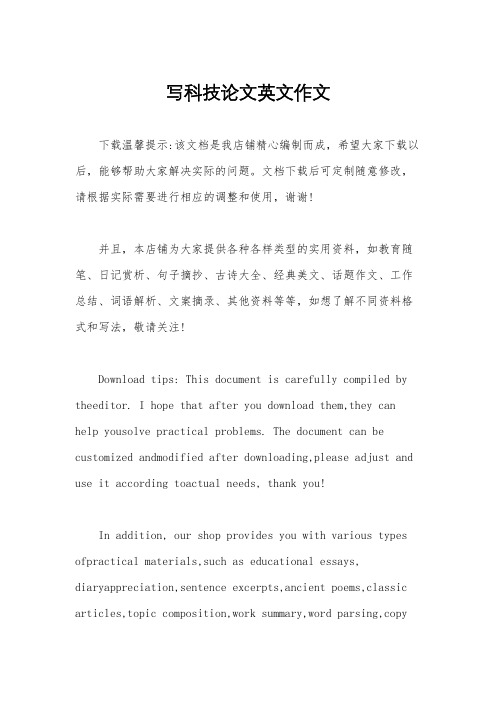
写科技论文英文作文下载温馨提示:该文档是我店铺精心编制而成,希望大家下载以后,能够帮助大家解决实际的问题。
文档下载后可定制随意修改,请根据实际需要进行相应的调整和使用,谢谢!并且,本店铺为大家提供各种各样类型的实用资料,如教育随笔、日记赏析、句子摘抄、古诗大全、经典美文、话题作文、工作总结、词语解析、文案摘录、其他资料等等,如想了解不同资料格式和写法,敬请关注!Download tips: This document is carefully compiled by theeditor. I hope that after you download them,they can help yousolve practical problems. The document can be customized andmodified after downloading,please adjust and use it according toactual needs, thank you!In addition, our shop provides you with various types ofpractical materials,such as educational essays, diaryappreciation,sentence excerpts,ancient poems,classic articles,topic composition,work summary,word parsing,copyexcerpts,other materials and so on,want to know different data formats andwriting methods,please pay attention!In today's fast-paced world, technology plays a crucial role in our daily lives. From smartphones to smart homes, technological advancements have revolutionized the way we live, work, and communicate. With each passing day, new innovations emerge, pushing the boundaries of what is possible. In this article, we will explore the impact of technology on various aspects of our lives and discuss its implications for the future.Let's start with the realm of communication. Gone are the days when we relied solely on landline telephones and snail mail to connect with others. Thanks to the advent of the internet and social media, we can now communicate with people from all corners of the globe in an instant. Whether it's through video calls, voice messages, or text chats, technology has made the world a smaller and more connected place.Moving on to the field of education, technology hastransformed the way we learn and acquire knowledge. With the rise of online courses and e-learning platforms, anyone with an internet connection can access a wealth of educational resources. This has democratized education, making it more accessible and affordable for people of all backgrounds. Additionally, interactive learning tools such as virtual reality and augmented reality have enhanced the learning experience, making it more engaging and immersive.In the healthcare sector, technology has brought about significant advancements that have improved patient care and outcomes. From electronic medical records to telemedicine, technology has streamlined healthcare processes, making them more efficient and accurate. Moreover, the development of medical devices and diagnostic tools has revolutionized the way diseases are diagnosed and treated. With the help of artificial intelligence and machine learning, healthcare professionals can now analyze vast amounts of data to make more informed decisions and provide personalized treatment plans.The impact of technology is not limited tocommunication, education, and healthcare. It has also transformed industries such as transportation, entertainment, and finance. Self-driving cars and electric vehicles are reshaping the way we travel, while streaming services and on-demand content have revolutionized the entertainment industry. In finance, technologies like blockchain and cryptocurrency are disrupting traditional banking systems, offering faster, more secure, and decentralized alternatives.As we look to the future, the possibilities of technology seem endless. From the development of artificial intelligence and robotics to the exploration of space and beyond, technology will continue to shape our world in ways we cannot yet imagine. However, it is essential to consider the ethical and social implications of these advancements. As technology becomes more integrated into our lives, we must ensure that it is used for the greater good and does not exacerbate existing inequalities.In conclusion, technology has become an integral part of our lives, transforming the way we communicate, learn,and live. Its impact can be seen in various sectors, from healthcare to entertainment, and its potential for the future is limitless. However, it is crucial to approach technological advancements with caution and consider their ethical implications. Only then can we harness the full potential of technology to create a better and more inclusive world.。
科学技术议论文英语作文
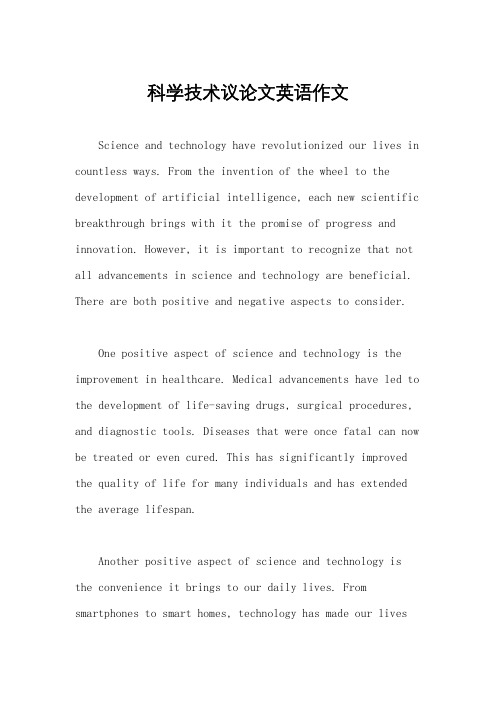
科学技术议论文英语作文Science and technology have revolutionized our lives in countless ways. From the invention of the wheel to the development of artificial intelligence, each new scientific breakthrough brings with it the promise of progress and innovation. However, it is important to recognize that not all advancements in science and technology are beneficial. There are both positive and negative aspects to consider.One positive aspect of science and technology is the improvement in healthcare. Medical advancements have led to the development of life-saving drugs, surgical procedures, and diagnostic tools. Diseases that were once fatal can now be treated or even cured. This has significantly improved the quality of life for many individuals and has extended the average lifespan.Another positive aspect of science and technology is the convenience it brings to our daily lives. From smartphones to smart homes, technology has made our liveseasier and more efficient. We can now communicate with people around the world in an instant, access information at our fingertips, and automate tasks that were once time-consuming. This has allowed us to be more productive and has opened up new opportunities in various fields.However, it is important to acknowledge the negative aspects of science and technology as well. One major concern is the impact on the environment. Industrialization and technological advancements have led to increased pollution, deforestation, and depletion of natural resources. This has resulted in climate change, loss of biodiversity, and other environmental problems. It is crucial for scientists and technologists to find sustainable solutions to minimize these negative effects.Another negative aspect of science and technology is the potential for misuse or abuse. Nuclear weapons, for example, have the power to cause mass destruction. Advances in genetic engineering raise ethical concerns about tampering with the natural order of life. It is important for society to have regulations and ethical guidelines inplace to ensure that science and technology are used for the benefit of humanity and not for harm.In conclusion, science and technology have brought about numerous positive changes in our lives, from advancements in healthcare to increased convenience. However, it is important to be mindful of the negative impacts, such as environmental degradation and thepotential for misuse. As we continue to make scientific and technological advancements, it is crucial to prioritize sustainability, ethics, and the well-being of both individuals and the planet.。
科研英文文章总结范文
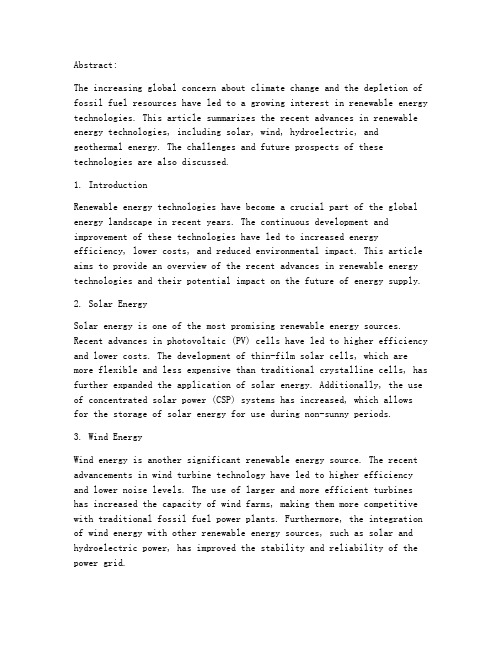
Abstract:The increasing global concern about climate change and the depletion of fossil fuel resources have led to a growing interest in renewable energy technologies. This article summarizes the recent advances in renewable energy technologies, including solar, wind, hydroelectric, and geothermal energy. The challenges and future prospects of these technologies are also discussed.1. IntroductionRenewable energy technologies have become a crucial part of the global energy landscape in recent years. The continuous development and improvement of these technologies have led to increased energy efficiency, lower costs, and reduced environmental impact. This article aims to provide an overview of the recent advances in renewable energy technologies and their potential impact on the future of energy supply.2. Solar EnergySolar energy is one of the most promising renewable energy sources. Recent advances in photovoltaic (PV) cells have led to higher efficiency and lower costs. The development of thin-film solar cells, which are more flexible and less expensive than traditional crystalline cells, has further expanded the application of solar energy. Additionally, the use of concentrated solar power (CSP) systems has increased, which allowsfor the storage of solar energy for use during non-sunny periods.3. Wind EnergyWind energy is another significant renewable energy source. The recent advancements in wind turbine technology have led to higher efficiency and lower noise levels. The use of larger and more efficient turbines has increased the capacity of wind farms, making them more competitive with traditional fossil fuel power plants. Furthermore, the integration of wind energy with other renewable energy sources, such as solar and hydroelectric power, has improved the stability and reliability of the power grid.4. Hydroelectric EnergyHydroelectric energy is one of the oldest and most established renewable energy sources. Recent advances in small-scale hydroelectric power plants have made them more accessible and cost-effective. Additionally, the use of run-of-the-river hydroelectric power plants, which do not require large reservoirs, has minimized environmental impact. The development of hydrokinetic energy, which harnesses the energy of flowing water, has also gained attention.5. Geothermal EnergyGeothermal energy is a renewable energy source that utilizes the Earth's internal heat. Recent advancements in geothermal power plants have led to increased efficiency and reduced costs. The development of enhanced geothermal systems (EGS) has expanded the potential for geothermal energy production, allowing for the exploitation of areas with low-grade geothermal resources.6. Challenges and Future ProspectsDespite the significant advancements in renewable energy technologies, several challenges remain. The intermittent nature of renewable energy sources requires the development of energy storage solutions, such as batteries and pumped storage systems. Furthermore, the integration of renewable energy into the existing power grid requires careful planning and management to ensure stability and reliability.The future of renewable energy technologies looks promising. With continued research and development, the efficiency, cost, and environmental impact of these technologies are expected to improve. As governments and private sectors increasingly invest in renewable energy projects, the global energy landscape is likely to shift towards a more sustainable future.7. ConclusionThe recent advances in renewable energy technologies have brought us closer to a sustainable and environmentally friendly energy future. Aswe continue to overcome the challenges associated with these technologies, the transition to renewable energy sources is inevitable. The global community must collaborate and invest in the development and deployment of renewable energy technologies to ensure a sustainable and prosperous future for all.。
中国科技的进步与发展英语结尾作文
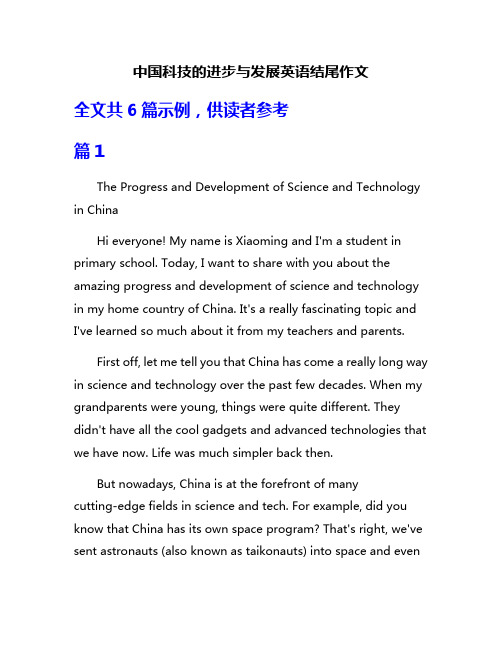
中国科技的进步与发展英语结尾作文全文共6篇示例,供读者参考篇1The Progress and Development of Science and Technology in ChinaHi everyone! My name is Xiaoming and I'm a student in primary school. Today, I want to share with you about the amazing progress and development of science and technology in my home country of China. It's a really fascinating topic and I've learned so much about it from my teachers and parents.First off, let me tell you that China has come a really long way in science and technology over the past few decades. When my grandparents were young, things were quite different. They didn't have all the cool gadgets and advanced technologies that we have now. Life was much simpler back then.But nowadays, China is at the forefront of manycutting-edge fields in science and tech. For example, did you know that China has its own space program? That's right, we've sent astronauts (also known as taikonauts) into space and evenhave our own space station orbiting the Earth. How awesome is that?Chinese scientists and engineers have also made incredible breakthroughs in areas like renewable energy, high-speed rail, and telecommunications. For instance, China has the world's largest network of high-speed trains, which can travel at speeds over 300 kilometers per hour! That's faster than some airplanes!In the field of artificial intelligence (AI), China is a global leader as well. Chinese companies like Baidu, Alibaba, and Tencent are at the forefront of developing AI technologies for things like facial recognition, natural language processing, and self-driving cars. AI is going to change the world in so many ways, and China is playing a huge role in shaping its future.But it's not just about cutting-edge technologies. China has also made remarkable strides in areas that impact our daily lives, like e-commerce and mobile payments. Thanks to companies like Alibaba and Tencent, millions of people in China can now shop online and make payments using their smartphones with just a few taps. It's so convenient!Of course, China's progress in science and technology wouldn't be possible without the hard work and dedication of countless researchers, engineers, and scientists. These brilliantminds are constantly pushing the boundaries of what's possible and making groundbreaking discoveries.One example that really inspires me is the story of Tu Youyou, a Chinese scientist who won the Nobel Prize in 2015 for her work in developing a new treatment for malaria. Despite篇2The Development of Science and Technology in ChinaWow, technology is so cool! There are so many amazing gadgets and inventions in China these days. Did you know that a lot of the stuff we use every day was created by Chinese scientists and engineers? China has made huge strides in science and technology over the past few decades. Let me tell you all about it!For a long time, China was behind many other countries when it came to high-tech research and development. But in recent years, the Chinese government has invested tons of money into supporting science, innovation, and cutting-edge industries. They realized how important it is for China's future to have a strong technological base.One area where China has become a global leader is telecommunications. Chinese companies like Huawei and ZTE are at the forefront of developing 5G networks and mobile devices. Their smartphones are used by millions of people worldwide. China also launched the world's largest 5G network, blanketing the entire country with super-fast internet connectivity.Have you heard of high-speed rail? The bullet trains in China are amazing! They can reach speeds over 300 km/h, getting you from city to city in a blur. China now has the longest high-speed rail network on the planet, with over 35,000 km of tracks crisscrossing the country. The trains use really advanced technology like autonomous driving systems, magnetic levitation, and aerodynamic designs. Riding on them is like being on a spaceship!Talking about space, China has also become a major player in space exploration. In 2003, the Shenzhou 5 mission made China the third country ever to launch a human into space after Russia and the USA. Since then, Chinese astronauts (or taikonauts as they call them) have gone on many space missions. China has its own space station, and there are plans for crewedmissions to the Moon. Who knows, maybe Chinese astronauts will be the first to set foot on Mars one day!You know those cute little robots that can dance, play games, and even do martial arts? A lot of those are made by Chinese tech companies. China is a leader in service robots and automation for homes, factories, hospitals and other places. The robots use advanced artificial intelligence to see, hear, move and make decisions. I wish I had a robot buddy to help me with chores and homework!Something China is really good at is renewable energy technology. They are the world's largest producer of solar panels, wind turbines and hydroelectric power. By 2030, they want to get a huge percentage of their electricity from clean energy sources like solar and wind farms. China is also a pioneer in areas like nuclear fusion research and hydrogen fuel technology. Moving away from fossil fuels is so important to protect our environment.Of course, China hasn't done all this alone. They have collaborated with scientists from many other nations. The world of science ties countries together as we all work on major challenges like disease, climate change, energy needs and so on.But there's no denying that Chinese technological capabilities have grown by leaps and bounds in just a few decades.It's really awesome to see China at the cutting edge of so many different fields - communications, transportation, space exploration, robotics, clean energy and more. Just think about how much everyday life has been transformed by Chinese innovations. Maybe some of you will become scientists and engineers yourselves, helping to create incredible new technologies for the world!In conclusion, China's rapid technological development over the past few decades has been remarkable. While initially lagging behind, increased government funding and focus on research and innovation have propelled China to the forefront of many cutting-edge fields like telecommunications, high-speed rail, space exploration, robotics, renewable energy and more. Through international collaboration and its own burgeoning domestic capabilities, China is playing an increasingly vital role in driving key technological progress that impacts and benefits people around the globe. With continued support for science, who knows what amazing Chinese innovations the future may hold? The prospects are incredibly exciting.篇3China's Amazing Science and Tech!Hi friends! Today I want to tell you all about the super cool science and technology that's happening in my country, China. Get ready to have your mind blown!First up, let's talk about space exploration. China has been rocketing ahead in this area, sending robots to explore the moon and even bringing back moon rocks to study on Earth. That's not all - in 2022, China finished building the Tiangong space station! Astronauts from China have been living and working up there, doing experiments and learning about life in space. I can't wait until regular people like me get a chance to visit!Speaking of crazy future plans, China is also a world leader in developing technology for super-fast transportation systems. They have bullet trains that go over 300 km/h - that's like the speed of a race car! Incredible rail lines now connect almost every corner of the country. But that's not even the coolest part. Chinese scientists are working on "super maglev" trains that could one day go over 600 km/h by floating over the tracks using powerful electromagnets. Zoom zoom!China has also become a powerhouse for renewable energy like solar, wind, and hydroelectric power. There are huge solar farms and wind farms stretching across the landscape, producingclean electricity. The Three Gorges Dam on the Yangtze River is one of the biggest hydroelectric power plants ever built. All this renewable energy helps cut down on pollution and protects the environment. Look up pictures of the solar farms at night - they almost look like alien landscapes with their glowing panels!If you think that's amazing, get this - China has also developed incredibly advanced nuclear fusion reactors that provide a nearly unlimited supply of clean energy. The reactor in Sichuan province is called "East Wind" and it's one of the first in the world to successfully achieve a self-sustaining fusion reaction at incredibly high temperatures. Physicists say this technology could one day provide power for the entire world with just a tiny amount of fuel and zero greenhouse gas emissions! How cool is that?Artificial intelligence篇4The Amazing Science and Tech of ChinaHi friends! Today I want to tell you all about the super cool science and technology happening in my home country of China. China has made so many amazing advances in lots of differentareas like space exploration, high-speed rail, artificial intelligence, renewable energy and more. Get ready to have your mind blown!Let's start by talking about China's space program. China has sent tons of satellites, probes, and rovers into space to explore the moon, Mars, and other planets and moons in our solar system. The Chang'e lunar missions have landed rovers on the moon to study the surface and even grow plants! The Tianwen-1 mission landed a rover on Mars in 2021. How cool is that? But China's biggest space accomplishment so far is the Tiangong space station. Multiple crews of taikonauts (Chinese astronauts) have lived and worked on Tiangong, conducting all kinds of experiments in the microgravity environment of space. Just imagining floating around a spaceship is so awesome!Speaking of awesome transportation, China is also a world leader in high-speed rail. China's high-speed rail network is the largest in the world, with over 25,000 miles of trackscriss-crossing the country. The bullet trains can reachmind-blowing top speeds of 350 km/h! That's like driving on the highway at 220 mph. Just zipping across long distances in a ultra-modern train...I'd love to experience that. High-speed rail makes it easy for people and goods to travel quickly across the huge distances in China. It's the future of transportation!Artificial intelligence (AI) is another area where Chinese scientists are doing cutting-edge work. AI refers to computer systems that can sense their environment, learn, solve problems, and make decisions in ways that mimic human intelligence. Chinese AI is being used for all sorts of applications like facial recognition, robotics, self-driving cars, data analysis, and more. Baidu is one of China's AI pioneers, with its Baidu Brain technology powering things like translation apps, self-driving cars, and smart home devices. AI is advancing so rapidly and I can't wait to see what new things it enables in the future!Green energy from renewable sources like solar, wind, and hydroelectric power is crucial for protecting the environment and achieving sustainable development. China is now a global leader in renewable energy, with the largest installed capacity of solar, wind, hydro and bio-energy projects in the world. China is massively investing in constructing gigantic solar and wind farms across the country to shift from dirty coal power to clean renewable energy. I love seeing all the solar panels on rooftops and the huge wind turbines stretching across fields. Green energy from the power of nature is amazing.Of course, those are just a few highlights of China's modern scientific and technological progress. There are so many otherfascinating areas like China's advances in 5G telecom networks, biotechnology, quantum篇5The Progress and Growth of Chinese TechnologyHi friends! Today I want to talk to you about something really cool - the amazing progress China has made in science and technology. China has come a long, long way and has turned into a super high-tech country!Let me start by telling you about how things used to be in the old days. When my grandparents were young, China was a pretty poor and backward place when it came to modern technology. Most people were farmers who lived in villages and didn't have access to things like computers, smartphones, or even reliable electricity. Can you imagine life without video games, the internet, and all the cool gadgets we have today? It must have been so boring!But China's leaders realized that to become a strong and prosperous nation, we needed to develop our scientific and technological capabilities. So they started investing a lot of money into research, building new universities and labs, andencouraging students to study subjects like engineering, computer science, and physics.And boy, did that investment pay off! Over the past few decades, China has gone from being a technological laggard to a true global powerhouse of innovation. We've made groundbreaking advances in areas like artificial intelligence, renewable energy, aerospace, biotechnology, and so much more. Chinese scientists and engineers are at the cutting edge of fields that will shape the future of our world.One area where China has become a dominant force is in information technology and telecommunications. Companies like Huawei, Oppo, Xiaomi, and ZTE have produced some of the world's most advanced smartphones, 5G networks, and other communications tech. Chinese social media and e-commerce platforms like WeChat and Alibaba are used by billions. We're also a leader in supercomputing, with some of the fastest and most powerful machines on the planet.China's capabilities in space exploration have also grown by leaps and bounds. We've launched numerous satellites for activities like weather monitoring, communications, and Earth observation. China's space program has sent robotic rovers to the Moon and deployed its own space stations. Pretty soon, wemay even have taikonauts walking on the lunar surface! Many experts predict it's only a matter of time before China becomes the world's pre-eminent space power.Our country has also emerged as the global leader in renewable energy technologies. China manufactures most of the world's solar panels and wind turbines. We've constructed some of the largest solar and wind farms anywhere. Renewable energy sources like hydropower, wind, and solar now account for over a quarter of China's total energy production. And we're continuing to make advances in areas like nuclear fusion, hydrogen power, and other clean energy frontiers.Perhaps most importantly, China has nurtured a new generation of brilliant and creative young minds in science, technology, engineering, and math (STEM) fields. More and more Chinese students are choosing to study these crucial subjects, sparking innovation and driving our technological progress. A growing entrepreneurial spirit, coupled withworld-class technical universities, has turned China into a startup powerhouse where new ideas are constantly being turned into new products and services.Of course, China's technological explosion has brought its share of challenges too. We've had to grapple with issues likeonline privacy, cybersecurity, and the ethical implications of powerful new technologies like artificial intelligence, genetic engineering, and automation. Not everyone has benefited equally from the tech boom, and we need to work harder to spread the benefits to all regions and all people. But overall, there's no doubt that China's transition into a mighty force of scientific and technological innovation has improved our lives in countless ways.Looking ahead, I can only imagine how mind-blowing China's technological accomplishments will be by the time I'm an adult. Maybe we'll have mastered nuclear fusion as an unlimited clean energy source. Perhaps we'll have permanently settled on Mars. Or we could even achieve the holy grail of science - creating artificial general intelligence that matches or exceeds human cognition. The possibilities are endless!At the end of the day, what makes me most proud as a Chinese citizen is that we are no longer just imitating or copying the innovations of others. More and more, China's scientists, engineers, and entrepreneurs are the ones conceiving and creating world-changing technologies from scratch. We are moving from the world's factory to becoming a global source oforiginal ideas and inventions that are profoundly shaping the future trajectory of human civilization.That's my overview of China's technological progress and achievements so far. It makes me incredibly excited to think about what wonders and breakthroughs we will unleash in the years and decades ahead! China's rise as a science and tech superpower is one of the most monumental stories of the 21st century. And it's just the beginning!In conclusion, the rapid technological development and progress that China has experienced in recent decades is truly remarkable. From humble beginnings as a largely agricultural society, China has transformed itself into a global powerhouse of innovation that leads the world in many cutting-edge fields. While challenges remain, the meteoric rise of Chinese science and technology fills me with immense national pride and optimism for what the future holds. With our brilliant scientists, engineers, and a new generation of STEM talent, the sky is the limit for how far China's technological capabilities can soar. I can't wait to see what amazing breakthroughs and advancements await us in the years ahead!篇6The Amazing Science and Tech of My Country ChinaWow, have you seen all the crazy cool science and tech stuff happening in my country China recently? It's been absolute fireworks of new inventions and discoveries! China is becoming a total powerhouse of innovation. As a curious kid who loves learning about science, I'm super excited to tell you all about it.First off, did you know that China has now launched more rockets into space than any other country? We've got a massive space station up there called Tiangong, which means "Heavenly Palace." How awesome is that? Chinese astronauts have been living and working up there, conducting experiments in zero gravity. We've even grown crops and bred animals in space! My dream is to become an astronaut and visit Tiangong one day.But China's science talents aren't just in space. We're also world leaders in fields like artificial intelligence, quantum computing, renewable energy, and tonnes of other cutting-edge areas. AI is especially cool - we have smart robots that can see, hear, and learn just like humans. I even have a little AI assistant on my phone that helps me with my homework!Speaking of tech that makes life easier, China is going totally crazy with stuff like high-speed rail, electric cars, and 5G telecom networks. My mom zips across the whole country on bullet trainsthat go over 300 km/h! And we've got electric car companies like BYD and Nio that are taking on the world. The cities are covered in 5G towers that make mobile internet fast as lightning.Of course, we can't forget about the immense construction projects happening here. The bridges, skyscrapers, dams, and transportation hubs we're building are simply mind-blowing in size and complexity. My jaw drops every time I see a new megacity emerging from the ground. Chinese engineers are amazing!But you know what I'm most stoked about? The amazing scientific discoveries coming from China! We've got brilliant minds making breakthroughs in fields like genetics, materials science, energy tech, and nanotechnology. Just last year, Chinese physicists achieved a major milestone by creating a sun-like source of infinite fusion energy in a laboratory.Whoa, mindblown! With feats like that, it's no wonder China is predicted to outspend the USA on scientific research very soon.I could go on and on listing China's sci-tech achievements, but I'll wrap it up now. Just know that us Chinese kids have sooooo many reasons to dream big about careers in science, technology, engineering, and math. The cutting-edge workhappening here will shape the entire world's future. China's time under the spotlight for innovation has definitely arrived!In conclusion, the progress and development of science and technology in China has been remarkable in recent years. From world-leading achievements in space exploration, artificial intelligence, and renewable energy, to major infrastructure projects and scientific discoveries, China is rapidly becoming a global powerhouse of innovation. As a young student with a passion for science, I am incredibly excited about the future possibilities that await in my country. China's investment and advancements in these critical fields will undoubtedly shape the world for generations to come.。
论文总结英文范文

The research paper titled "The Impact of Technology on Education" investigates the integration of technology in the field of education and its subsequent effects on students' learning outcomes. This summary aims to provide a comprehensive overview of the key findings and discussions presented in the paper.The paper begins by highlighting the rapid advancements in technology over the past few decades and their subsequent influence on various aspects of human life. In the context of education, the integration of technology has become increasingly prevalent, with numerous educational institutions adopting digital tools and platforms to enhance the learning experience.The first section of the paper focuses on the benefits of technology in education. The author argues that technology can offer students a more engaging and interactive learning environment. By incorporating multimedia resources, such as videos, simulations, and interactive quizzes, technology can help cater to different learning styles and improve students' understanding of complex concepts. Furthermore, technology can facilitate personalized learning, allowing students to progress at their own pace and receive targeted feedback.The paper also discusses the potential drawbacks of technology in education. One major concern is the digital divide, which refers to the disparity in access to technology and digital resources betweendifferent socioeconomic groups. This divide can lead to unequal learning opportunities and perpetuate social inequalities. Additionally, the overuse of technology can result in students becoming overly reliant on digital devices, leading to reduced critical thinking and problem-solving skills.The next section of the paper explores the role of teachers in the integration of technology in education. The author emphasizes the importance of professional development for teachers to equip them with the necessary skills and knowledge to effectively utilize technology in the classroom. By providing teachers with training and support, educational institutions can ensure that technology is used as a tool to enhance learning rather than a distraction.The paper further examines the impact of technology on assessment and evaluation in education. The author argues that technology canfacilitate more efficient and accurate assessments, allowing teachers to track students' progress and identify areas of improvement. Additionally, digital platforms can offer a wide range of assessment tools, such as online quizzes and automated grading systems, which can save teachers time and effort.The final section of the paper presents recommendations for policymakers, educational institutions, and teachers to maximize the benefits of technology in education. The author suggests that governments should invest in improving digital infrastructure and ensuring equitable access to technology. Educational institutions should provide ongoing training and support for teachers to develop their technological skills. Furthermore, the paper emphasizes the need for a balanced approach to technology integration, ensuring that it complements rather thanreplaces traditional teaching methods.In conclusion, the research paper on "The Impact of Technology on Education" provides a comprehensive analysis of the effects oftechnology integration in the field of education. The paper highlights the numerous benefits of technology in enhancing the learning experience, while also acknowledging the potential drawbacks and challenges. By offering practical recommendations and insights, the paper contributesto the ongoing discourse on how technology can be effectively utilizedto improve education for all students.。
英语科技论文写作作文

英语科技论文写作作文The Impact of Technology on Education。
Introduction。
Technology has become an integral part of our everyday lives, and its impact on education has been significant. In recent years, there has been a growing emphasis on integrating technology into the classroom, and this has led to a number of changes in the way that education is delivered. In this paper, we will explore the impact of technology on education, focusing on the benefits and challenges that it presents.Benefits of Technology in Education。
One of the most significant benefits of technology in education is the ability to personalize learning. With the use of technology, students can access a wide range of resources and materials that cater to their individuallearning styles and abilities. This allows for a more personalized approach to education, which can lead to improved learning outcomes.Additionally, technology has made education more accessible. With the use of online learning platforms and resources, students can access educational materials from anywhere in the world. This has opened up new opportunities for students who may not have had access to traditional educational resources.Technology has also made learning more engaging and interactive. With the use of multimedia resources, students can interact with educational materials in a way that is more immersive and interactive. This can lead to increased engagement and motivation, which can ultimately improve learning outcomes.Challenges of Technology in Education。
科技英语作文总结

科技英语作文总结In the realm of English composition, technology has become an indispensable subject that not only shapes our daily livesbut also influences the way we communicate and learn. As we delve into the topic of technology in our essays, we uncover several key areas that are essential to explore.1. The Evolution of Technology:The first aspect to consider is the historical development of technology. From the invention of the wheel to the digital age, each technological leap has transformed society in profound ways. Essays can trace these developments,highlighting the milestones that have shaped our modern world.2. Impact on Communication:The advent of the internet and social media hasrevolutionized how we interact. English compositions can discuss the positive and negative impacts of these platformson interpersonal communication, including the rise of digital literacy and the potential for misinformation.3. Technological Advancements in Education:Education has been significantly impacted by technology.Online learning platforms, digital textbooks, and virtual classrooms are now commonplace. Essays can analyze how these tools have changed the learning process, the benefits of remote education, and the challenges it presents.4. Artificial Intelligence and the Future of Work:Artificial intelligence (AI) is a hot topic in technology. English compositions can speculate on the future of work in the age of AI, discussing how automation might change job markets, the skills needed for the workforce of tomorrow, and the ethical considerations surrounding AI.5. Environmental Implications:Technology's environmental footprint is a critical issue. Essays can examine the role of technology in bothcontributing to and mitigating climate change, exploring renewable energy sources, and the sustainable practices adopted by tech companies.6. Privacy and Security:With the rise of technology comes the issue of privacy and security. English compositions can delve into the challenges of maintaining privacy in a digital age, the importance of cybersecurity, and the measures taken by governments and corporations to protect user data.7. The Digital Divide:The digital divide is a global issue where access to technology is unequal. Essays can discuss the social and economic implications of this divide, the efforts to bridge the gap, and the role of technology in promoting global equality.8. Technological Innovations in Healthcare:Healthcare has been greatly enhanced by technology, from telemedicine to advanced prosthetics. English compositionscan explore how these innovations have improved patient care, the ethical considerations of medical technology, and the future of healthcare.9. The Role of Technology in Creativity:Technology has also played a significant role in the arts, from digital art to music production software. Essays can discuss how technology has expanded creative possibilities and the impact on traditional art forms.10. The Ethical Debates Surrounding Technology:Finally, English compositions can engage with the ethical debates surrounding technology, such as the implications of surveillance, the responsibility of tech companies, and the balance between innovation and regulation.In conclusion, technology is a multifaceted subject that offers a wealth of topics for English composition. By examining these areas, students can develop a nuanced understanding of the role technology plays in our world and the implications for the future.。
关于科技英文作文结尾
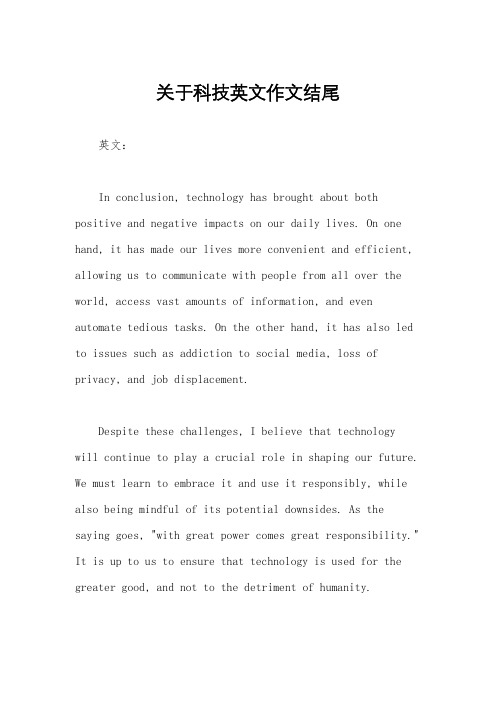
关于科技英文作文结尾英文:In conclusion, technology has brought about both positive and negative impacts on our daily lives. On one hand, it has made our lives more convenient and efficient, allowing us to communicate with people from all over the world, access vast amounts of information, and even automate tedious tasks. On the other hand, it has also led to issues such as addiction to social media, loss of privacy, and job displacement.Despite these challenges, I believe that technologywill continue to play a crucial role in shaping our future. We must learn to embrace it and use it responsibly, while also being mindful of its potential downsides. As the saying goes, "with great power comes great responsibility." It is up to us to ensure that technology is used for the greater good, and not to the detriment of humanity.中文:总之,科技对我们的日常生活带来了积极和消极的影响。
英语科技论文(5篇)
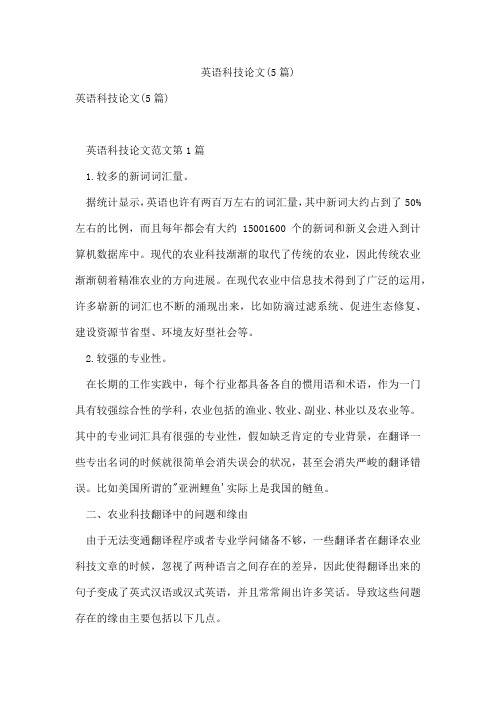
英语科技论文(5篇)英语科技论文(5篇)英语科技论文范文第1篇1.较多的新词词汇量。
据统计显示,英语也许有两百万左右的词汇量,其中新词大约占到了50%左右的比例,而且每年都会有大约15001600个的新词和新义会进入到计算机数据库中。
现代的农业科技渐渐的取代了传统的农业,因此传统农业渐渐朝着精准农业的方向进展。
在现代农业中信息技术得到了广泛的运用,许多崭新的词汇也不断的涌现出来,比如防滴过滤系统、促进生态修复、建设资源节省型、环境友好型社会等。
2.较强的专业性。
在长期的工作实践中,每个行业都具备各自的惯用语和术语,作为一门具有较强综合性的学科,农业包括的渔业、牧业、副业、林业以及农业等。
其中的专业词汇具有很强的专业性,假如缺乏肯定的专业背景,在翻译一些专出名词的时候就很简单会消失误会的状况,甚至会消失严峻的翻译错误。
比如美国所谓的"亚洲鲤鱼'实际上是我国的鲢鱼。
二、农业科技翻译中的问题和缘由由于无法变通翻译程序或者专业学问储备不够,一些翻译者在翻译农业科技文章的时候,忽视了两种语言之间存在的差异,因此使得翻译出来的句子变成了英式汉语或汉式英语,并且常常闹出许多笑话。
导致这些问题存在的缘由主要包括以下几点。
1.没有储备足够的农业专业学问。
我们都知道,现在许多翻译人员都是在英语相关专业毕业的,很少了解相关的农业学问,所以许多的望词生义的现象消失在了实际的翻译过程中。
比如在对landreform进行翻译的时候应当将其翻译成"农业改革'或者"草地改革',而不应当翻译成"'。
"肥'这个常常消失在高校《土壤学》课程中的词假如处于不同的语境就会有不同的翻译方法,例如肥料应当翻译成为fertilizer,追肥应当翻译成为topdressing,底肥应当翻译成为basemanure。
假如在进行农业专业翻译的过程中,翻译人员只具备了肯定的语言基础,却缺乏过硬的专业学问,就很简单消失各种错误。
科学论文格式英语作文

科学论文格式英语作文Title: The Effects of Technology on Education。
Abstract:In recent years, technology has become an integral part of education. The use of technology in education hasbrought about significant changes in the way students learn and teachers teach. This paper examines the effects of technology on education, including the benefits and challenges that come with its use. It also explores the future of technology in education and the potential impactit may have on the field.Introduction:Technology has revolutionized the way we live our lives, and education is no exception. The use of technology in education has brought about significant changes in the way students learn and teachers teach. With the rise of digitaltechnology, education has become more accessible and convenient for students. This paper examines the effects of technology on education and the potential impact it may have on the field.Benefits of Technology in Education:The use of technology in education has numerous benefits. Firstly, technology has made education more accessible. Students can now access educational resources from anywhere in the world using the internet. Secondly, technology has made learning more engaging and interactive. With the use of multimedia tools, students can learn in a more visual and interactive way, which makes learning more fun and engaging. Thirdly, technology has made it easierfor teachers to assess student learning. With the use of online quizzes and tests, teachers can easily track student progress and identify areas where students need help.Challenges of Technology in Education:Despite the benefits of technology in education, thereare also some challenges that come with its use. Firstly, there is a risk of technology replacing human interaction. Students may become too reliant on technology and lose the ability to communicate effectively with others. Secondly, there is a risk of technology becoming a distraction. Students may become too focused on their devices and lose focus on their studies. Lastly, there is a risk of technology being used for cheating. Students may use technology to cheat on tests and assignments, which can undermine the integrity of the education system.Future of Technology in Education:The future of technology in education is promising. With the rise of artificial intelligence and virtual reality, education is set to become even more interactive and engaging. AI-powered tutoring systems will provide personalized learning experiences for students, while VR technology will allow students to explore and learn in immersive environments. However, there are also concerns about the impact of technology on jobs in the education sector. With the rise of technology, there is a risk ofteachers being replaced by machines.Conclusion:In conclusion, technology has had a significant impact on education. While there are benefits to its use, there are also challenges that need to be addressed. As technology continues to evolve, it is important that wefind ways to harness its potential while also addressingits risks. The future of education is exciting, but we must ensure that we use technology in a responsible and ethical way.。
2023年大学英语学术论文写作与翻译期末结课论文
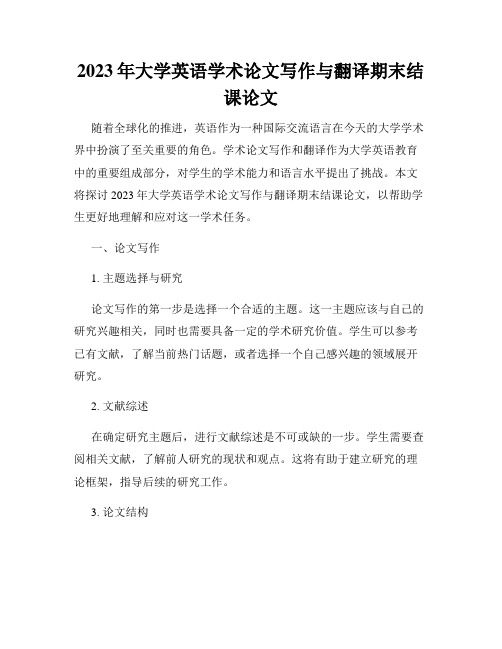
2023年大学英语学术论文写作与翻译期末结课论文随着全球化的推进,英语作为一种国际交流语言在今天的大学学术界中扮演了至关重要的角色。
学术论文写作和翻译作为大学英语教育中的重要组成部分,对学生的学术能力和语言水平提出了挑战。
本文将探讨2023年大学英语学术论文写作与翻译期末结课论文,以帮助学生更好地理解和应对这一学术任务。
一、论文写作1. 主题选择与研究论文写作的第一步是选择一个合适的主题。
这一主题应该与自己的研究兴趣相关,同时也需要具备一定的学术研究价值。
学生可以参考已有文献,了解当前热门话题,或者选择一个自己感兴趣的领域展开研究。
2. 文献综述在确定研究主题后,进行文献综述是不可或缺的一步。
学生需要查阅相关文献,了解前人研究的现状和观点。
这将有助于建立研究的理论框架,指导后续的研究工作。
3. 论文结构一篇学术论文通常包括引言、文献综述、研究方法、研究结果、讨论和结论等部分。
学生需要明确每个部分的内容和目的,确保论文结构清晰有序。
4. 研究方法研究方法部分应描述研究的具体步骤,包括数据收集方法、样本选择以及数据分析方法。
学生需要清晰地陈述他们的研究方法,以确保研究的可信度。
5. 结果与讨论在结果部分,学生需要呈现他们的研究结果,包括图表和数据。
在讨论部分,他们应该解释这些结果的意义,并与文献综述中的研究进行对比和分析。
6. 引用和参考文献在整篇论文中,学生需要合理引用已有文献,并在参考文献部分列出所有引用的文献。
引用规范和准确性对于避免抄袭和确保学术诚信非常重要。
二、翻译除了学术论文写作,翻译也是本课程的一项重要任务。
翻译要求学生将一篇英文学术文章翻译成中文,以提高他们的语言能力和跨文化交流技能。
1. 语言翻译在翻译过程中,学生需要注意语言的准确性和流畅性。
他们应该尽量保持原文的意思,同时适应中文的表达方式,确保翻译通顺自然。
2. 专业术语学术文章中通常包含大量的专业术语,学生需要熟悉这些术语的中文翻译,以确保翻译的准确性。
关于科技论文写作课程的期末英文论文
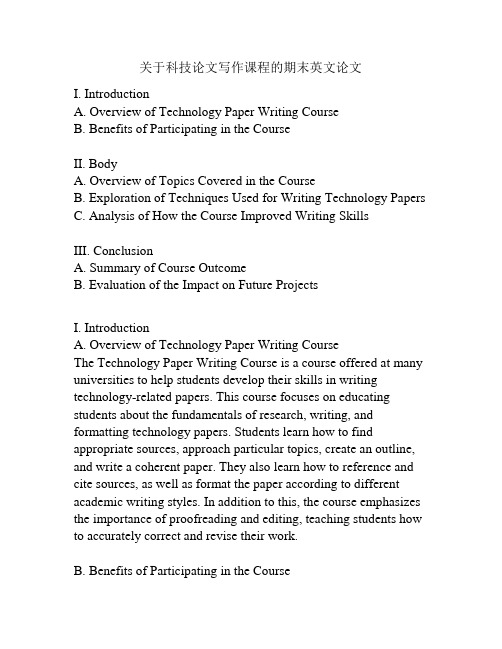
关于科技论文写作课程的期末英文论文I. IntroductionA. Overview of Technology Paper Writing CourseB. Benefits of Participating in the CourseII. BodyA. Overview of Topics Covered in the CourseB. Exploration of Techniques Used for Writing Technology PapersC. Analysis of How the Course Improved Writing SkillsIII. ConclusionA. Summary of Course OutcomeB. Evaluation of the Impact on Future ProjectsI. IntroductionA. Overview of Technology Paper Writing CourseThe Technology Paper Writing Course is a course offered at many universities to help students develop their skills in writing technology-related papers. This course focuses on educating students about the fundamentals of research, writing, and formatting technology papers. Students learn how to find appropriate sources, approach particular topics, create an outline, and write a coherent paper. They also learn how to reference and cite sources, as well as format the paper according to different academic writing styles. In addition to this, the course emphasizes the importance of proofreading and editing, teaching students how to accurately correct and revise their work.B. Benefits of Participating in the CourseParticipating in the Technology Paper Writing Course provides many benefits for students. It teaches them the basics of writing technology papers, allowing them to confidently tackle research-based assignments. Additionally, the course helps students understand the importance of structure and organization, demonstrating how each element contributes to the overall quality of the paper. Lastly, the course allows students to fine-tune their writing skills, giving them the tools to approach any type of assignment with ease. Not only is the Technology Paper Writing Course beneficial in the academic setting, but it is also applicable to any kind of professional venture.II. BodyA. Overview of Topics Covered in the CourseThe Technology Paper Writing Course covers a wide range of topics related to writing technology papers. It starts off with teaching students about the basics of research, such as how to find reliable sources and approach particular topics. Students are also introduced to the concept of creating an outline and structuring a paper, as well as how to write a clear and effective introduction. In addition to this, the course covers topics on referencing and citing sources, as well as formatting techniques for different academic writing styles.B. Exploration of Techniques Used for Writing Technology Papers The Technology Paper Writing Course helps students explore various techniques for writing effective technology papers. Through the course, students learn how to conduct effective research, create an outline, and structure their papers logically. Additionally, they are taught how to incorporate sources into thepaper in an appropriate manner, and how to use formatting tools to ensure the paper is presented professionally. The course also emphasizes the importance of proofreading and editing, showing students how to effectively eliminate errors and revise their work.C. Analysis of How the Course Improved Writing Skills Participating in the Technology Paper Writing Course helped me tremendously improve my writing skills. Before taking the course, I lacked structure and organization in my papers, making them incoherent and difficult to understand. However, after completing the course, I was able to apply the principles introduced to me, making my papers more concise, structured, and clear. Additionally, I learned valuable techniques for researching and citing sources, making my papers more accurate and well-rounded. Through the Technology Paper Writing Course, I was able to become a more confident and competent writer.III. ConclusionA. Summary of Course OutcomeThe Technology Paper Writing Course provided a comprehensive overview of the principles and techniques for writing technology papers. Through the course, I was able to understand the basics of research, structure, organization, and formatting. Additionally, I learned techniques for referencing and citing sources, as well as proofreading and editing my work. By going through the course, I was able to become a more confident and competent writer, allowing me to tackle research-based assignments with ease.B. Evaluation of the Impact on Future ProjectsThe skills and knowledge learned through the Technology PaperWriting Course will have long-lasting benefits on my future projects. Not only will it help me write better and more informative technology papers, but it will also be applicable to any type of writing assignment. Furthermore, the course has shown me the importance of proofreading and editing my work, giving me the tools to ensure the accuracy of my papers. Going through the course has been an invaluable experience, equipping me with the necessary skills to excel in my academic and professional endeavors.。
英语学科节科技类小作文
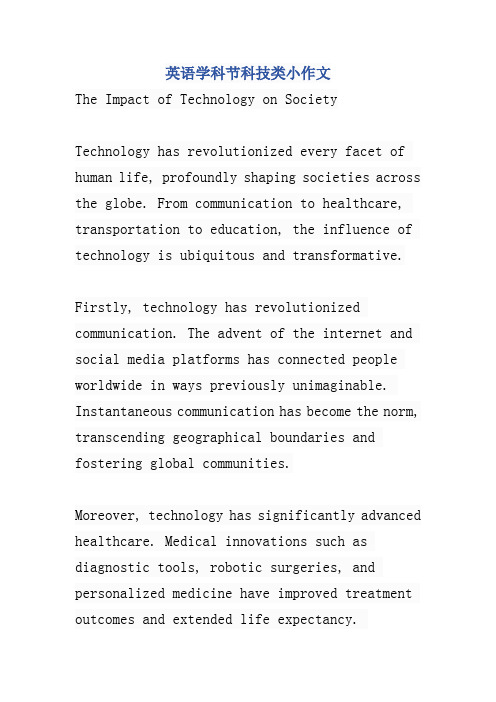
英语学科节科技类小作文The Impact of Technology on SocietyTechnology has revolutionized every facet of human life, profoundly shaping societies across the globe. From communication to healthcare, transportation to education, the influence of technology is ubiquitous and transformative.Firstly, technology has revolutionized communication. The advent of the internet and social media platforms has connected people worldwide in ways previously unimaginable. Instantaneous communication has become the norm, transcending geographical boundaries and fostering global communities.Moreover, technology has significantly advanced healthcare. Medical innovations such as diagnostic tools, robotic surgeries, and personalized medicine have improved treatment outcomes and extended life expectancy.Telemedicine has further democratized access to healthcare, particularly in remote areas.In transportation, technology has revolutionized efficiency and safety. Electric vehicles, autonomous driving technologies, and high-speed trains have reduced carbon footprints and transformed urban mobility. Real-time navigation apps optimize travel routes, minimizing congestion and enhancing commuter experiences.Education has also undergone a digital transformation. Online learning platforms offer flexible and accessible educational opportunities globally. Interactive simulations and virtual classrooms enrich learning experiences, catering to diverse learning styles and preferences.Furthermore, technology has catalyzed economic growth and innovation. Digital economies, powered by e-commerce and fintech innovations,have created new business models and entrepreneurial opportunities. Artificial intelligence and big data analytics optimize operations, driving productivity and competitiveness across industries.However, amidst these advancements, challenges such as digital divides, data privacy concerns, and ethical implications of technology use have emerged. Bridging these gaps and ensuring equitable access to technology remains imperative for inclusive societal development.In conclusion, technology continues to redefine societal norms, enhancing connectivity, efficiency, and quality of life. Embracing technological advancements responsibly, while addressing associated challenges, is essential in shaping a sustainable and inclusive future for humanity. As technology evolves, so too must our commitment to harness its potential for the greater good of society.。
科技英语期末总结范文

科技英语期末总结范文Introduction:Technology has become an essential part of our daily lives. From smartphones to smart homes, technology has advanced rapidly over the years, bringing great convenience and efficiency to our lives. This summary aims to provide an overview of the key technological advancements in various fields and their impact on society. Additionally, it will explore the challenges and benefits that technology brings to our lives and discuss its role in shaping the future.1. Telecommunications:The telecommunications industry has revolutionized the way we communicate. With the advent of the internet, smartphones, and social media platforms, distance is no longer a barrier to communication. The rapid development of 5G technology has further enhanced the speed and accessibility of internet connections, allowing for faster data transfer and more efficient communication. This advancement has greatly benefited businesses, education, and healthcare sectors, and has improved global connectivity.2. Artificial Intelligence (AI):AI has emerged as a powerful technology with applications in various fields. Machine learning algorithms have enabled AI systems to learn from data and make predictions or take actions independently. AI has found immense use in the healthcare industry, where it has helped diagnose and treat diseases, increasing efficiency and accuracy. In the education sector, AI-powered systems offer personalized learning experiences to students, tailoring education to individual needs. While AI brings many benefits, it also raises concerns about privacy, ethics, and job displacement.3. Internet of Things (IoT):The IoT refers to the interconnection of everyday objects via the internet, enabling them to send and receive data. This connectivity has resulted in the creation of smart homes, smart cities, and even smart industries. Smart homes allow individuals to control various aspects such as lighting, temperature, and security remotely through smartphone apps. Smart cities use IoT-enabled devices to manage traffic, waste, and energy consumption, resulting in more sustainable and efficient urban living. However, the proliferation of IoT devices also poses cybersecurity risks that need to be addressed.4. Big Data and Analytics:The digital age has brought an enormous amount of data being generated every second. Big data refers to the huge volumes of structured and unstructured data that organizations collect. Analytics tools and techniques help analyze this data to gain valuable insights for decision-making. Big data analytics has significant applications in business operations,marketing, healthcare, and research. The ability to make data-driven decisions has revolutionized these industries, leading to optimization, cost reduction, and enhanced customer experiences.5. Renewable Energy:Technological advancements have also played a crucial role in the development and utilization of renewable energy sources. Solar panels, wind turbines, and hydroelectric power plants have become more efficient and accessible, reducing our reliance on fossil fuels. These advancements have led to a cleaner and more sustainable energy landscape, contributing to the fight against climate change. Additionally, energy storage technologies, such as batteries and fuel cells, have improved, making renewable energy sources more reliable and viable.Conclusion:Technology continues to shape our lives and society at an unprecedented rate. The advancements in telecommunications, AI, IoT, big data, and renewable energy have brought numerous benefits, such as improved communication, personalized experiences, efficient resource management, and reduced environmental impact. However, along with these benefits come challenges that need to be addressed, including privacy concerns, cybersecurity threats, and ethical implications. As we move forward, it is crucial to find a balance between harnessing the potential of technology and mitigating the associated risks. Only then can we fully embrace the transformative power of technology and create a better future for all.。
科学实验课英语作文结尾

科学实验课英语作文结尾Science Experiment: The Key to Unlock the Mysteries of Nature.The scientific method is the cornerstone of modern science. It provides a structured and systematic approach to investigating and understanding the natural world. Through a series of carefully designed experiments, scientists can test hypotheses, collect data, and draw conclusions about the workings of our universe.In a science experiment, the first step is to formulate a hypothesis. This is a tentative explanation or prediction about the relationship between two or more variables. The hypothesis should be specific and testable, meaning that it should be possible to design an experiment to validate or refute it.Once a hypothesis has been formulated, the next step is to design an experiment. This involves identifying theindependent and dependent variables, as well as the control group. The independent variable is the variable that is manipulated or changed by the experimenter. The dependent variable is the variable that is measured or observed in response to the manipulation of the independent variable. The control group is a group of subjects that is not exposed to the independent variable. This group serves as a basis for comparison, allowing the experimenter to determine whether the observed changes in the dependent variable are due to the independent variable or to other factors.Once the experiment has been designed, it is time to collect data. This involves making careful observations and measurements. The data should be recorded in a clear and concise manner, so that it can be easily analyzed and interpreted.After the data has been collected, it is time to analyze the results. This involves looking for patterns and trends in the data. Statistical tests can be used to determine whether the observed differences between theexperimental and control groups are statistically significant. If the differences are significant, then the hypothesis can be supported.However, it is important to note that rejecting a hypothesis does not necessarily mean that the hypothesis is false. It simply means that the experiment did not provide sufficient evidence to support the hypothesis. Further experiments may be needed to determine whether the hypothesis is truly false or whether it simply needs to be modified.The scientific method is an iterative process. Scientists often repeat experiments multiple times, using different methods and controls, to ensure the validity of their results. This process of refinement and repetition helps to build a solid foundation of knowledge upon which new discoveries can be made.In conclusion, science experiments are essential to understanding the natural world. They allow scientists to test hypotheses, collect data, and draw conclusions aboutthe workings of our universe. The scientific method is a powerful tool for discovery, and it has led to countless advances in our understanding of the world around us.。
- 1、下载文档前请自行甄别文档内容的完整性,平台不提供额外的编辑、内容补充、找答案等附加服务。
- 2、"仅部分预览"的文档,不可在线预览部分如存在完整性等问题,可反馈申请退款(可完整预览的文档不适用该条件!)。
- 3、如文档侵犯您的权益,请联系客服反馈,我们会尽快为您处理(人工客服工作时间:9:00-18:30)。
英语科技论文写作结课论文The Preparation and Research Of Epoxy Resin Modified Water-bone Polyurethane Emulsion1. IntroductionThere are various types of raw materials for synthetic water-bone polyurethane emulsion, including not only main raw materials such as isocyanates of polyurethane resin、polyhydric alcohols or polyamine , but also auxiliary raw materials like chain extender、catalytic agent、neutralizer. By different synthetic processes and compound designs we can produce water-bone polyurethanes with different properties[1]. The great advantage of water-bone polyurethane is using water as dispersion medium, the method we use to compose water-bone polyurethane is self-emulsification method, as it need not to add emulsification. As the epoxy resin has many excellent properties: great binding power and intensity, and it has hydroxide radical which can react with –NCO in polyurethane then reach the aim of modifying polyurethane[2]. This modification overcomes the polyurethane’s shortcoming to a large extent[3]. In our experiment , we discussed the temperature and time of pre-polymerization 、the temperature of emulsification、the R value、the addition of DMPA、the molecular weight of PEG、the addition of BDO and EDA, then make sure the best matching. Afterwards we use epoxy resin to modify PU, and discussed the addition of DMPA、the different kinds of epoxy resins and the addition to affect the properties of water-bone PU, then determine the best matching of the addition of DMPA and epoxy resin which enhanced the properties of PU the greatest degree[4].2. ExperimentWe first studied the reaction temperature, reaction time on the properties of water-bone polyurethane emulsion. Then in the best reaction temperature and time we discussed different ratio of raw materials affected the water-bone polyurethane emulsion’s appearance、storage stability and the waterproof、the mechanical property and the heat endurance of the coating. From this we obtained the best formula.The preparation of epoxy resin modified water-bone polyurethane emulsion mainly divided into two stages[5]: The first stage is pre-polymer, and the main reaction is the –NCO in MDI react with –OH in PEG to produce Carbamic acid ester bond, when added DMPA then –COOH added, afterwards added BDO to increase the length of the chain, the last adding the –OH to bring in the epoxy groups; The second stage is neutralization emulsification. We cooled the pre-polymer to 30°, then add TEA to neutralize –COOH, followed under the action of high-speed shearing join EDA aqueous emulsion, among this the epoxy ring opening to –OH. At last the epoxy resin modified water-bone polyurethane emulsion made.The picture in the following is the analysis of FTIR of the epoxy、the water-bone polyurethane emulsion and the epoxy modified water-bone polyurethane emulsion.Wavenumber(cm-1)Picture 1 The FTIR of epoxy、WPU emulsion and epoxy modified WPU emulsion (a: epoxy; b: WPU emulsion; c:epoxy modified WPU emulsion) The analysis of FTIR indicated that after epoxy modified, -NCO reacted with the –OH in the epoxy and formed carbamic acid ester, also the picture showed that the epoxy introduced to the main chain of WPU successfully. Besides, the picture illustrated that in the process of modifying the ring opening reaction happened.3. ConclusionThe results indicated that the prepared waterborne polyurethane emulsion shows pretty appearance and excellent stability, as the pre-polymerization reaction time and temperature are respectively 180min and 70℃as well as the emulsification temperature being 30℃; With the increase of R and DMPA content, the tensile strength of waterborne polyurethane film also increased and the breaking elongation tend to decrease, however, the water resistance of the film decreased with the increase of the R value and increased with the increase of the DMPA content. Thereby, the optimum R and optimal content of DMPA were determined respectively as 1.7 and 5%~7%; additionally, taking PEG as material, which has larger relative molecular mass, the prepared waterborne polyurethane emulsion appears brilliantly and shows great stability as the contents of BDO and EDA are 6%~8% and 2% respectively. Moreover, it was measured that the water absorption, tensile strength and breaking elongation of the film are respectively 11.46%, 10.46MPa and 402%. Although little change happens to the appearance and stability of the waterborne polyurethane emulsion, which was modified by EP, the water resistance, mechanical properties and thermal stability of the film show great change along with the different additions of EP. According to the research, the waterborne polyurethane emulsion shows better performance as the EP content is 8%. Furthermore, the performance of the waterborne polyurethane emulsion modified by E-44 is better than that modified by E-51. Thewater absorption, tensile strength and breaking elongation of the film, which are modified by E-44, are respectively 8.41%, 15.52MPa and 318%. TG analysis indicated that the thermal stability of the film, which was modified by EP significantly improved. Moreover, the thermal stability of the film, which was modified by E-44, is better than that, which was modified by E-51. According to the FTIR analysis, the EP has been successfully introduced to the waterborne polyurethane Molecular chain, and Ring-opening happened.4. References[1]Pan Zuren. Polymer chemistry [M]. Beijing: Chemistry industry press, 2007, 47-49.[2]Noble K L. Waterborne polyurethanes[J]. Progress in Organic Coatings, 1997, 32(4):131-136.[3]Erica Scrinzi, Stefano Rossi, Flavio Deflorian, et al. Evaluation of aesthetic durability ofwaterborne polyeurthane coatings applied on wood for interior applications[J]. Progress in Organic Coatings. 2011, 72: 81-87.[4]Zhou Xinhua, Tu Weiping, Hu Jianqing. Preparation and Characterization of Two-componentWaterborne Polyurethane Comprised of Water-soluble Acrylic Resin and HDI Biuret[J].Chinese J. Chem. Eng. 2006, 14(1): 99-104.[5]Wang Jiong, Li Guoping. Research progress of water-bone polyurethane modified [J].Polymer materials science and engineering. 2009, 25(12): 166-168。
